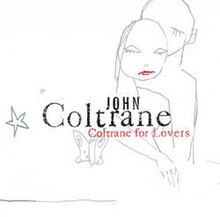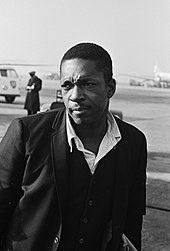Coltrane for Lovers
| Coltrane for Lovers | ||||
|---|---|---|---|---|
 | ||||
| Compilation album by | ||||
| Released | January 23, 2001 | |||
| Recorded | 1961–63 | |||
| Studio | Van Gelder (Englewood Cliffs) | |||
| Genre | ||||
| Length | 50:53 | |||
| Label | ||||
| Producer |
| |||
| John Coltrane chronology | ||||
| ||||
Coltrane for Lovers is a
The recordings on Coltrane for Lovers initially received criticism for Coltrane's stylistic move from complex jazz compositions of the free jazz form to a simpler formula of ballads and blues. In the years since, they gained a legacy as one of Coltrane's most popular recordings and significant in the romantic jazz mode. For their inclusion on Coltrane for Lovers, the tracks were selected by producer Richard Seidel and remastering engineer Allan Tucker at Foothill Digital in New York City.
As the first release in the Verve for Lovers series, Coltrane for Lovers was issued 33 years after Coltrane's death and nearly 40 years after the original recording dates. The album charted at number 10 on
Background

Shortly before completing his contract with
During this period of Coltrane's recording career, critics and fans were fiercely divided in their estimation of Coltrane, who had radically altered his style from
John Coltrane's primary record producer,
Recordings and composition
The recordings featured on Coltrane for Lovers were made between December 1961 and April 1963, during his
Recording for the collaboration LP John Coltrane and Johnny Hartman (1963) found the "classic quartet" backing up singer Hartman on ballad standards.[5] Rolling Stone magazine later described the album as "...one of Coltrane's least innovative records, but impeccably dignified and elegant",[5] and music critic Richard S. Ginell commented by saying that "Coltrane's eloquence and the warm, masculine baritone of Hartman can still break your heart."[12] Renowned writer and poet Al Young wrote of the album's most well-known recording, "My One and Only Love", and interpretation of the song by Coltrane and Hartman:
Without using words, great jazz interpreters make you feel the emotions that linger in the words and quiver between the words to the songs they perform. If, for example, you know the lyric to Robert Mellin and Guy Wood's "My One and Only Love", you dissolve at once into the undulant sea of John Coltrane's poetic paraphrase of that unremitting declaration of love... With the husky yet tender voice of Trane's tenor saxophone backing you, the very thought of you lover makes your heart sing like that April breeze on the wings of spring. You have no trouble picturing the splendor of it; the shadows that fall in the hush of night; and arms, those knowing arms and lips so tender, so warm that the heavenly touching of hands can only lead to sweet surrender.[13]
Shortly after the release of his ballad-oriented albums, Coltrane returned to a more experimental phase, recording Impressions (1963) and A Love Supreme (1965). In spite of this, the previous serious of ballad-oriented recordings served in helping increase Coltrane's legacy and influence on romantic jazz.[14]
Compilation and release
Coltrane for Lovers compiled eleven of the recordings from the aforementioned period seen best fit by the compilation's producers for a romance-themed compilation. The album was released in the United States by the
The album served as the first of several other For Lovers compilations that the Verve label would later issue, including recordings by Sarah Vaughan, Chet Baker, and Charlie Parker.[17] A similar compilation, entitled Plays for Lovers, was released by Prestige in 2003.[18] Another Verve compilation of Coltrane ballads, entitled More Coltrane for Lovers, followed in 2005.[19]
Critical reception
In a four-star review,
The recordings compiled for Coltrane for Lovers have endured a legacy as one of Coltrane's best performing and interpreting of ballads and standards.[13] In a September 2000 essay on the recordings, writer Al Young elaborated on John Coltrane's ability during the period of recording the compiled jazz ballads, writing that "The rapport between performer and audience smooths and deepens when a player of John Coltrane's caliber breathes personal expression into some aspect of a song's lyric or meaning."[13] Young continued in his review of the album, stating:
Jazz soloists are always expected to meet listener expectations. "You tell your story" is how twentieth-century soloists described the way they had their way with a song, as it were. They interpret, they embellish, and they set or induce a mood. Not only are musicians expected to coax personal meaning from songs ... we generally expect them to know the lyrics ... For Coltrane, blues and ballads were anything but separate; each told a story. And he was a superb teller of love stories. Listen to the glistening tenderness of his delivery ... Coltrane for Lovers contains some of the most romantic and popular music ever recorded. Revered by musicians, critics, and music fans alike, John Coltrane set the standard for ballads.[13]
In a 2007 interview for Esquire magazine, author and Coltrane biographer Ben Ratliff praised Coltrane's music and balladry, stating "His work contains most of the well-known ideals of jazz... If you're interested in improvisation, this guy pushed improvisation to the wall. He was the best blues player of his time. He wrote and played incredible ballads. Record companies are still putting out compilations of Coltrane ballads called Coltrane for Lovers or whatever. You can poke fun at the idea, but if you ever listen to one, they're indescribably beautiful."[23]
Track listing
| No. | Title | Writer(s) | Recorded | Length |
|---|---|---|---|---|
| 1. | " Nancy (With the Laughing Face)" | Jimmy Van Heusen, Phil Silvers | 9/18/62 c | 3:17 |
- Track sources
- a originally from Coltrane (1962)
- b originally from Duke Ellington and John Coltrane(1962)
- c originally from Ballads (1962)
- d originally from John Coltrane and Johnny Hartman (1963)
- e originally from Impressions (1963)
Charts
- 2001: Top Jazz Albums – #10 (63 weeks)[16]
Personnel
Musicians
|
|
Production
|
|
References
- ^ a b Porter 1999, pp. 197-198.
- ^ "NEA Jazz Masters: RVG". National Endowment for the Arts. Archived from the original on September 17, 2008. Retrieved June 26, 2008.
- ^ "John Coltrane Discography – session index". Jazz Discography Project. Retrieved August 11, 2008.
- ^ "Down Beat - Coltrane and Dolphy answer critics". Maher Publications. Archived from the original on October 11, 2007. Retrieved June 26, 2008.
- ^ a b c "John Coltrane biography". Rolling Stone. Archived from the original on June 18, 2008. Retrieved June 19, 2008.
- ^ "Coltrane – Ballads – Impulse!". Verve Music Group. Retrieved June 26, 2008.
- ^ Allmusic. Retrieved on July 19, 2009.
- ^ Al Young (2001). Coltrane for Lovers album liner notes. The Verve Music Group, a Division of UMG Recordings, Inc.
- ^ "Ballads > Overview". All Media Guide, LLC. Retrieved June 26, 2008.
- ^ "AllAboutJazz.com – Ballads: Remembering John Coltrane". All About Jazz. June 2001. Retrieved June 26, 2008.
- ^ "Review: Duke Ellington & John Coltrane". All Media Guide, LLC. Retrieved June 26, 2008.
- ^ "Jazz Standards – My One and Only Love: CD Recommendations for This Tune". JazzStandards.com. Retrieved June 26, 2008.
- ^ a b c d Young (2001), pp. 6-7.
- ^ Porter 1999, pp. 224-226.
- ^ a b "Verve Music Group – Coltrane for Lovers". Verve Music Group. Retrieved June 26, 2008.
- ^ a b "John Coltrane Coltrane For Lovers Chart History". Billboard. Retrieved July 8, 2018.
- ^ "Verve Music Group – Series". Verve Music Group. Archived from the original on June 12, 2011. Retrieved June 26, 2008.
- ^ "John Coltrane > Discography > Compilations". All Media Guide, LLC. Retrieved June 30, 2008.
- ^ "Verve Music Group – More Coltrane for Lovers". Verve Music Group. Retrieved June 26, 2008.
- ^ Ratliff, Ben. Review: Coltrane for Lovers. The New York Times. Retrieved on July 19, 2009.
- ^ "John Coltrane; Live Trane". Jazzitude, Marshall Bowden. Archived from the original on June 1, 2008. Retrieved July 15, 2008.
- ^ Richard Cook and Brian Morton, The Penguin Guide to Jazz on CD, 7th edn (London: Penguin, 2004), p. 343.
- ^ "John Coltrane Biography – Esquire". Hearst Communications, Inc. August 14, 2007. Retrieved July 15, 2008.
Bibliography
- Al Young (2001). Coltrane for Lovers album liner notes. The Verve Music Group, a Division of UMG Recordings, Inc.
- ISBN 0-472-08643-X.
- Nathan Brackett, Christian Hoard (2004). The New Rolling Stone Album Guide. excerpt by ISBN 0-7432-0169-8.
- Richard Cook, Brian Morton (2002). The Penguin Guide to Jazz on CD. Edition 6. ISBN 0-14-051521-6.

